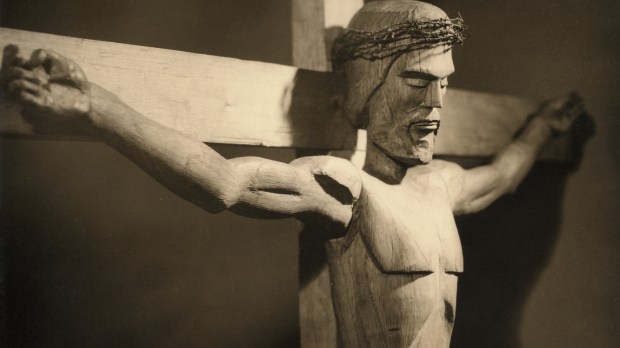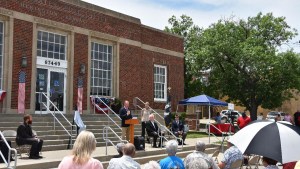The spiritual, emotional, and physical support that Fr. Emil Kapaun provided for soldiers during the Korean War is legendary. The fact that he provided it with no concern for his own life or comfort is the reason many think his virtue was heroic.
Even a Jewish POW who suffered in the same prison camp where Fr. Kapaun died recognized his sanctity. He believed in it so much that he allowed himself to fashion an object that some of his fellow Jews might consider a blasphemy.
Fr. Kapaun, a native Kansan, was serving with the 3rd Battalion of the 8th Cavalry during the Korean War, which began on June 25, 1950. The battallion was overrun by a much larger contingent of Chinese soldiers after North Korea’s communist neighbor entered the war effort in late 1950.
Under fire, Fr. Kapaun rescued about 30 wounded soldiers and ministered to countless others. Along with other soldiers captured during the Battle of Unsan, Fr. Kapaun was put on a 60-mile forced march to Prisoner of War Camp #5. Even then, he sought to save as many lives as he could, carrying wounded soldiers and persuading his fellow POWs to do the same, so that the captors wouldn’t “put them out of their misery.” Kapaun negotiated with the captors to spare the life of a soldier who was about to be executed.
Although he spent a mere seven months in the prison camp, Kapaun poured out his life for others: giving up his own rations or stealing food and medicine so the men would have enough to sustain life; providing spiritual and pastoral care; nursing the sick back to health. He himself developed pneumonia and a blood clot in his leg, and the captors took him to the camp “hospital,” where, as everyone knew, the neglect was so bad that no one came out alive. Even so, Fr. Kapaun insisted on bringing with him his sacred oils and a stole so that he could minister to his fellow doomed POWs.
A unique memorial
After the death of their beloved chaplain on May 23, 1951, his men agreed to honor the memory of someone who had “spoken, acted, and looked like Christ” with a homemade crucifix. The religious image also sustained the men for the rest of their own captivity. On the day they were released, a small contingent of them took the crucifix and processed into the “Freedom Village” where they would be repatriated.
The three-foot crucifix was sculpted by a Jewish POW, Marine fighter pilot Maj. Gerald Fink, from Chicago. According to the National Museum of American Jewish Military History, Fink arrived at the camp a few weeks after Kapaun’s death. “Even so, after hearing many stories about the chaplain,” Fink decided to make the crucifix.
Fink had been physically and mentally tortured as a POW. He was held in horrible conditions such as frequent solitary confinement. To counter the effects of that treatment, he kept himself busy doing woodworking. “He made his own tools in the prison camp, and created items such as baseball bats and a prosthetic leg,” according to the museum’s website.
Capt. Ralph A. Nardella, a fellow POW, said years later that it took Fink about two and a half months to make the crucifix.
“Before embarking on this project, Gerry had to fashion his own tools,” Nardella said in a letter quoted in the first book about Kapaun, The Story of Chaplain Kapaun, by Msgr. Arthur Tonne. “He made a knife out of the steel arch support of a discarded army boot, a chisel out of a drain pipe bracket, and a mallet. The wood was selected from the pile, which we used for fuel, after many days of searching for a suitable piece. The corpus stands about 26 inches high and is made from scrub oak. The cross stands about 40 inches high and is made from cherrywood. His crown of thorns, resembling barbed wire, was made from old scrap pieces of radio wire. We entitled it ‘Christ in Barbed Wire.’ Most of the carving was done during daylight hours and without the permission of the guards.”
“Symbolic beginning of cause for sainthood”
When it was done, Nardella would suspend the crucifix from the ceiling to use it during prayer services. Fr. Kapaun had asked him to lead a regular schedule of Rosary and other prayers after his death. While some of the Chinese guards showed respect to the crucifix, Nardella recalled, “others, who had no Christian contacts, just gaped at it.”
The prison authorities, who had given the POWs daily indoctrination sessions about the evils of capitalism and the glories of communism, didn’t want to let the men carry the crucifix with them when they were released at the end of hostilities. “I had to haggle and argue to get it out,” Nardella said. “They referred it to ‘higher headquarters’ before I got permission.”
There’s no indication that Fink eventually became a Christian, but he showed signs of his sympathy toward the Christian faith, referring at one point to Nardella as “one of the finest Christian officers I’ve ever met.”
“It took a real man to practice his religion in a prison camp in the face of constant opposition,” Fink said.
In October of 1953, Fink enrolled Fr. Kapaun in the Jesuit Seminary Association so that Masses would be offered for the deceased chaplain. He had the certificate sent to Elizabeth and Enos Kapaun, the priest’s parents.
Today, Fink’s crucifix is housed at Kapaun Mt. Carmel Catholic High School in Wichita. Fink and Nardella were present for the dedication of the school in 1956.
A replica made by Stilwell, Kansas, church goods brokerage Fynders Keepers was made for a wall display in the Cathedral of the Immaculate Conception in Wichita, where Fr. Kapaun’s long-missing remains are now located after he was identified and returned to the Diocese of Wichita in 2021.
“In many ways, the crucifix is the symbolic beginning of Fr. Kapaun’s cause for sainthood, said Scott Carter, Coordinator of the Office for the Beatification of Father Emil Kapaun. “At the end of his life, the chaplain had brought the men so close to our Lord, that he in fact appeared in their minds and hearts as an Alter Christus, another Christ. In order to keep his memory and spirit alive in their hearts, they carved the crucifix. They carried it with them to freedom, and the first thing they did was tell Fr. Kapaun’s story to the world. It’s because of the Prisoners of War and their love for Kapaun that we have a cause for sainthood today.”
Said the National Museum of American Jewish Military History, “Though the circumstances for its creation may have been atypical, [Fink] was proud of his creation his entire life. Gerald Fink died in 1987, but will forever be remembered as the Jewish officer who made a crucifix for a Catholic chaplain.”



